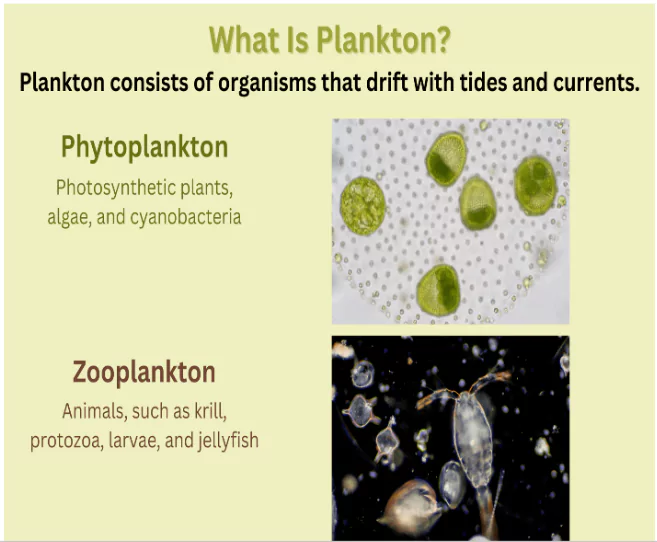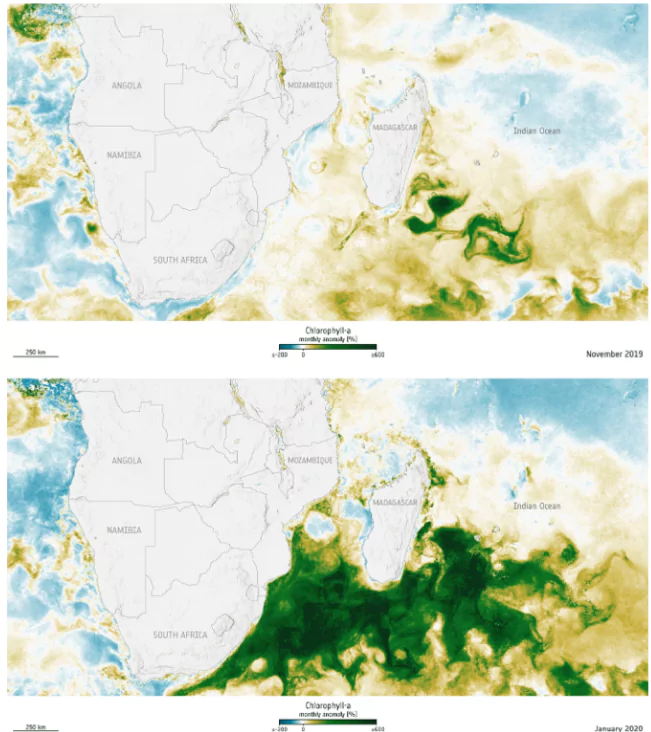Recently, scientists found evidence that desertification leads to large amounts of nutrient-rich dust landing in the Indian-Ocean, south east of Madagascar, causing phytoplankton (Algae) bloom.
About Phytoplanktons
- Definition: Phytoplanktons are tiny microscopic plants that float in water bodies and serve as primary producers in aquatic ecosystems.
- Role in Ecosystem: They perform photosynthesis, absorbing carbon dioxide and releasing oxygen.
Enroll now for UPSC Online Course
Desertification
- Desertification refers to land degradation in arid, semi-arid, and dry semi-humid areas resulting from various human impacts.
- It reduces the land’s potential for biological productivity, and causes conversion of productive lands used for pasture and agriculture into desert-like conditions.
|
-
- They are found near the water’s surface due to their reliance on sunlight.
- They include a variety of marine autotrophs such as diatoms, dinoflagellates, green algae, and blue-green algae.
Plankton: Classification and Importance
- Definition: Plankton are small organisms that drift with ocean currents and cannot swim against them.
- The term “plankton” is derived from the Greek word meaning “drifter” or “wanderer.”
- Types of Plankton:
- Phytoplankton: Plant-like organisms that perform photosynthesis.
- Zooplankton: Animal-like organisms that feed on phytoplankton and smaller marine species.
- Significance of Plankton:
- Phytoplankton contribute more than half of Earth’s oxygen.
- They serve as bioindicators, reflecting the health of ocean ecosystems.
- They form the base of the marine food web, supporting zooplankton, fish, and larger marine species.
- They help reduce global warming by absorbing human-induced carbon dioxide.
|
-
- They are mighty carbon sinks in their own right. They capture about 37 billion metric tons of carbon dioxide (that’s an estimated 40 per cent of all CO2 produced!) and produce at least 50 per cent of all oxygen in our atmosphere.
- Chlorophyll and Photosynthesis:
- Phytoplankton biomass is studied by analyzing Chlorophyll-a, the primary pigment used in photosynthesis.
- Photosynthesis: The process by which light energy is converted into chemical energy through the synthesis of organic compounds.
- Types of Chlorophyll:
- Chlorophyll a: Found in higher plants, algae, and cyanobacteria.
- Chlorophyll b: Found in green algae and higher plants.
- Chlorophyll c: Found in diatoms, dinoflagellates, and brown algae.
- Chlorophyll d: Exclusive to red algae.
Check Out UPSC NCERT Textbooks From PW Store

Phytoplankton Blooms
- Definition: Phytoplankton blooms refer to the exponential growth of phytoplankton, which can change the color of the water due to their dense population.
- Causes of Blooms:
- Eutrophication: Excess nutrients, such as nitrogen and phosphorus, promote algal growth.
- Temperature: Warmer water temperatures, typically in summer or fall, encourage blooms.
- Turbidity: Low turbidity allows sunlight to penetrate deeper into the water, enhancing growth.
 Impacts of Blooms:
Impacts of Blooms:-
- Positive:
- Enhance the marine food web by increasing zooplankton and fish populations.
- Act as temporary carbon sinks, absorbing atmospheric CO₂ during photosynthesis.
- Negative:
- Produce biotoxins that can bioaccumulate in marine food chains.
- Deplete oxygen levels in water, creating hypoxic “dead zones.”
Indian Ocean Bloom (2019-2020)
- A rare and unprecedented phytoplankton bloom occurred south-east of Madagascar during November 2019–January 2020.
 The bloom covered ~2,000 km² and was detected using satellite technology that identified chlorophyll presence.
The bloom covered ~2,000 km² and was detected using satellite technology that identified chlorophyll presence.
- Causes:
- The bloom was caused by nutrient-rich dust from drought-stricken regions in southern Africa, such as the Etosha salt pans, Namib Desert, and Kalahari pan belt.
- The dust was transported by winds and deposited into nutrient-deficient waters by intense rainfall events.
- Impacts:
- Potential increase in zooplankton and fish populations due to the abundant food supply.
- High photosynthesis rates during the bloom transformed the region into a significant carbon sink, absorbing large amounts of CO₂.
Link to Global Warming
- Trends:
- Rising air temperatures, increasing aridity, and higher dust emissions in southern Africa may lead to more frequent blooms.
- Events like droughts and megafires (e.g., in Australia) contribute aerosols and nutrients to oceans, enhancing blooms.
- Potential Benefits: Dust fertilization of oceans may help mitigate global warming by temporarily increasing carbon absorption.
- Concerns: Further research is required to understand long-term ecological and climatic impacts.
Enroll now for UPSC Online Classes
Significance for Climate Regulation
- Phytoplankton blooms highlight the interconnectedness of terrestrial and marine ecosystems in the context of global warming.
- While blooms can act as natural carbon sinks, their negative effects on marine ecosystems require careful management.
![]() 26 Nov 2024
26 Nov 2024


 Impacts of Blooms:
Impacts of Blooms: The bloom covered ~2,000 km² and was detected using satellite technology that identified chlorophyll presence.
The bloom covered ~2,000 km² and was detected using satellite technology that identified chlorophyll presence.